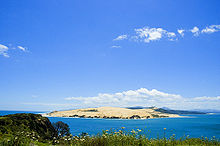


The Hokianga area surrounds the Hokianga Harbour in the Northland region of the North Island of New Zealand. It is sparsely populated and has many little clusters of houses in a very rural setting. The density of population is less than one per square kilometre. A good place to relax and chill out.
The icon for the Hokianga is the kauri tree, with 75% of all kauri trees being in the Hokianga. It has four protected kauri forests: Waipoua in the south-west, Omahuta to the north-east, Warawara in the north-west and Puketi in the east.
Towns
- 1 Horeke – the oldest Hokianga town and second oldest European settlement in New Zealand
- 2 Kohukohu – a historic town with interesting buildings and many artists
- 3 Koutu – large concretions (boulders) on the shore
- 4 Mangamuka Bridge – kauri forest reserve
- 5 Opononi – town on the south side of the harbour that became famous through Opo, a dolphin
- 6 Rawene – a historic and picturesque village on a peninsula jutting into the harbour
Other destinations
- 1 Waima Valley (valley along the Waima river with settlements of Taheke and Waima)
Understand
Its full Māori name is Hokianga-nui-a-Kupe, the returning place of Kupe, the legendary Polynesian discoverer of New Zealand 800–1,000 years ago. The entrance to the beautiful harbour is guarded by two headlands that legend tells are the taniwha who accompanied Kupe to this country. The North Head is called Niniwa and the South Head is Arai-te-Uru. The eleven rivers that feed the Hokianga are the paths their children made.
The population is 6,000–7,000 of whom 60% are of Māori descent, Te Rarawa iwi in the north, Ngapuhi iwi in the south. Many people are descendants of early European settlers as well as being able to trace their Māori ancestry back to Rahiri.
The remoteness of the Hokianga, combined with a lack of investment in the region, gave it a reputation as being one of the most poverty-stricken parts of the country. This neglect caused the area to remain pristine, unspoilt, untouched and untamed.
The climate is sub-tropical: bananas, figs and peaches grow wild. Horticulture is gradually making a come-back after years of neglect.
There are many arts-related activities from country and western music to film and book festivals, kapa haka and jazz.
Hokianga Health Enterprise Trust runs the hospital and the health system which includes district nurses in nine clinics, a dental service and other services such health promotion. The Trust is elected by the community and the doctors work for salaries. On a per capita basis, it is the most efficient and effective health service in the country.
Get in
From Dargaville drive 54 km northwards on State Highway 12 (SH 12) past the Waipoua Forest info spot. The Hokianga starts at the parking for Tane Mahuta.
From Kaikohe drive westward on State Highway 12. After about 9 km you will drive into a basin, which is where the Hokianga starts.
From the Bay of Islands, Fullers GreatSights operate daily tours to the Hokianga and Waipoua Forest.
Get around
There is no public transport in the Hokianga. To explore, you need a vehicle or boat. A vehicle ferry crosses the harbour between Rawene and Kohukohu.
See



- Tane Mahuta, Waipoua Forest, State Highway 12 (18 km south of Omapere, and 65 km north of Dargaville). A giant kauri tree, the largest living kauri. A 200 metre walk from the car park. Keep to the track to avoid spreading kauri dieback disease and damaging tree roots.
- Historic buildings such as Clendon House at Rawene and Mangungu Mission House at Horeke
- Wairere Boulders – an enormous basalt flow near Horeke
- Biggest concretions in the world at Koutu
- Sand dunes – fantastic sandstone sculptures on top of dune accessed from Opononi or Kohukohu
- Omahuta Kauri Sanctuary near the town of Mangamuka Bridge
Itineraries
- Hokianga round trip. Total time 2 days. Start in any of these towns: Horeke, Mangamuka Bridge, Kohukohu, Rawene, Waima or Taheke. For instance start in Horeke and visit the Wairere Boulders and Mangungu Mission House. This will take you about half a day. Continue your trip to State Highway 1 and drive to Mangamuka Bridge. About 1 km before the town, turn left to experience the Omahuta Kauri Sanctuary. Continue the trip to Kohukohu. This will take you about half a day. Have a look around Kohukohu. Cross the harbour on the vehicle ferry and look around Rawene. Drive to the turnoff on State Highway 12 and turn left towards the Waima Valley and continue your trip to your starting point Horeke.
- South side trip. Total time 2 days. Start in Horeke and visit the Wairere Boulders and Mangungu Mission House. This will take you about half a day. Drive to Taheke where you turn right into State Highway 12 and follow the Waima Valley westward. Follow the road to the turnoff to Rawene. Follow the road, park close to the ferry terminal and look around Rawene. This will take you about half a day. Return to the turnoff on State Highway 12 and turn right towards Opononi/Omapere. Drive through Whirinaki and after descending a long hill, turn into Koutu Loop Road on the right. Visit the Koutu Boulders. Return to SH 12 and turn right, follow the road to Opononi. Park your vehicle and take the passenger ferry across the harbour. Walk up to the sand dunes and return on the ferry. Continue your trip towards Omapere and follow SH 12 till you see the carpark for Tane Mahuta.
Do
- Hiking in the forests
Eat
Drink
Sleep
Go next
- Bay of Islands – historic area and very popular tourist destination to the east
- Far Far North – to the north
- Lower Northland – to the south

